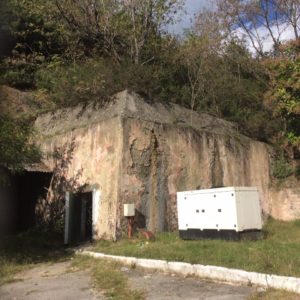
Hoxha built his nuclear bunker to survive an expected nuclear attack. Photo by Robert Waite
In the second part of a two-part series, contributing writer Robert Waite finally gets to turn his Albanian travel dream into reality. Among other things, he finds a wealth of bizarre historical remnants — including former dictator’s Enver Hoxha’s vast nuclear bunker — which have now become tourist attractions.
Here’s Part I of the series, By Travel Obsessed: Albanian Edition, in case you missed it.
By Robert Waite
Tirana, Albania – After narrowly escaping having our car impounded and my decades-long dream of visiting Albania dashed, we were finally on our way.
Barred from driving ourselves, we engaged Roberto, a Dubrovnik-based guide, to take us to Kotor in Montenegro.
Along the way, he proved quite gregarious, providing colorful commentary on the traits we should expect to observe upon meeting the locals in Kotor. It was like someone from New York talking about the Ozarks. I was finally beginning to understand why Yugoslavia fell apart so completely into jostling rival states after the death of the “benevolent dictator” Tito in 1980.
In reality, we found the people we met in Montenegro perfectly pleasant. But we needed to move on – we had a Film Festival in Tirana to catch and a country to see.
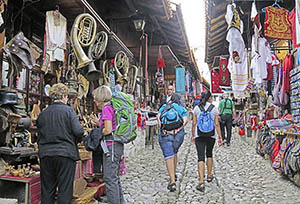
Bazaar in Kruja, Albania.
Photo by Dennis Cox/WorldViews
Following Roberto’s advice, we caught a bus from Kotor to Tirana, via the Montenegro capital, Podgorica.
When you cross into Albania, you enter into a rugged rural landscape framed by the “Accursed Mountains” – probably not a name meant to entice visitors (all I could think of when I first heard the name was “The Cliff of Insanity” from the film “The Princess Bride”).
On To Tirana
We had originally planned to stay a few days in Shkodra, the center of Northern Albanian Gheg culture, but needed to press on to Tirana for a scheduled interview with the Film Festival’s Director, Agron Domi. However, the town, and the adjacent lake of the same name, certainly looked worthy of a visit.
Albanians are descended from the ancient Illyrian people, and their language and traditions are not related to other European ethnic groups.
As a nation, Albania first asserted itself in the middle 15th century, when a charismatic leader, Skanderberg, led a struggle against the Turks. But the Turks finally won control in 1478 and dominated Albania, as they did much of the Balkans, until independence in 1912.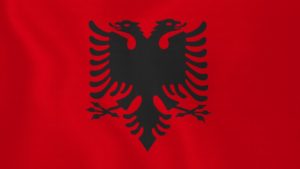
Albania, although technically sovereign, was economically dominated by Italy, which subsequently invaded. After a period of German Nazi occupation, the country was liberated by partisan communist forces led by Enver Hoxha.
Hoxha was originally strongly aligned with the Soviet Union and its leader, Josef Stalin. But with Stalin’s death and denunciation by Nikita Khrushchev, Hoxha, a true believer in Stalinism, broke ties with the USSR.
For a period Albania aligned with China, but when that country also rejected Stalinism, Hoxha and Albania in 1977 cut off China and virtually all ties with the outside world.
Bunker Mania
What this produced was one of the most bizarre and paranoid regimes in world history. For example, as you travel south towards Tirana, you will see many medieval castles dotting the hillsides. But you will see something else as well – squat concrete bunkers.
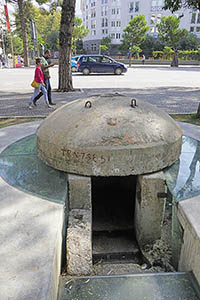
Defensive bunker in Duress, Albania. Photo by Dennis Cox/WorldViews
Hoxha came to believe that everyone – Americans, Russians, British, and, eventually, the Chinese – was out to get him. He feared a nuclear attack and during the period from the mid-1960’s until his death he had an astounding 173,371 bunkers constructed. This happened at a time when Albania was the poorest country in Europe and barely able to feed its population.
Also, quite famously, a couple of Greek tourists, enjoying a tropical beverage while on floatation devices, drifted too far and were machine-gunned by dutiful Albanian border guards. Not exactly a welcome mat.
Hoxha ruthlessly suppressed religion during his reign, once claiming to have “the world’s only 100 percent atheist country.”
Ironically, one of the world’s best-known religious figures of the day — Mother Teresa, known for tending to the poor in Kolkata, India — was Albanian. A decade ago Albania tried to have her body repatriated from India with no success, but Tirana’s international airport is named for her.
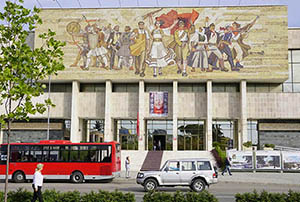
The National History Museum in Tirana, Albania. Photo by Dennis Cox/World Views
Hoxha also throttled any communications that might create discord. For example, at the time of the overthrow of the communist regime, the country had only three cinemas – this in a country with 2.5 million people and roughly the size of Maryland.
My HuffPost article was titled “A Tale of Two TIFF’s”, contrasting the Tirana International Festival with that in Toronto. One was a fledgling; the other was deemed by many, including Variety and The Hollywood Reporter, as being too big for its own good.
International Reach
Agron Domi turned out to be a great interview and his Festival, today in its 18th year, was a marvel, attracting entries from not only the Balkans, but the UK, the United States and other nations.
But of course we were in Tirana for more than the Film Festival – and you should be, as well.
The place to head first is the immense Skanderberg Square at the center of the city, surely built to Stalinesque dimensions by Hoxha. Here you will find the National History Museum, which offers a comprehensive view of the country’s past and its post-communist present. It is well signed in English, always a plus.
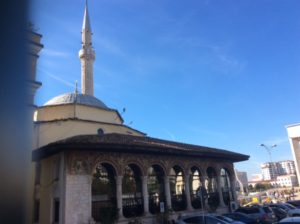
This mosque in Tirana survived the anti-religious Hoxha regime. Photo by Robert Waite.
Nearby is the National Art Museum. The 19th century art on display is pretty predictable in terms of following French trends. But the gallery depicting the communist period, replete with toiling workers and farmers – so-called “Socialist Realism” – is a rare blast from the past. The closest you come to this genre might be the few remaining W.P.A. murals adorning U.S. Post Offices.
Also on the square is the Et’hem Bey Mosque. Islam is the most commonly practiced religion today. About 37% of the population self-identify as Muslim – a remarkable number considering the decades-long effort to stamp out religion all together.
In that context it is something of a miracle that this small mosque survived at all. It is one of the oldest buildings in the city and one can see Ottoman architectural influences, including the carving around the upper section, reserved for women.
We had our doubts about Albanian food (fueled in part by Albanian expats who previously derided the cuisine), but were very pleasantly surprised. Freedom has been good to the Albanian food scene and Tirana has a number of good restaurants serving both local dishes and Italian favorites.
Local dishes include Qofte, meatballs made with minced lamb; speca me glize, peppers stuffed with cottage cheese, and tave kosi, the national dish, a casserole made with lamb and rice and baked with yoghurt and eggs (or soured milk).
Our favorite restaurant ended up being the one in our hotel, Dinasty, which specialized in locally sourced truffles to create a fabulous risotto. That dish alone was worth the drive.
No ‘Duck and Cover’
But the highlight of any visit to Tirana is something called “Bunk Art.” Located away from the city center, this massive underground structure was built by Enver Hoxha to house not only him, but his entire government, during the ever-expected nuclear attack.
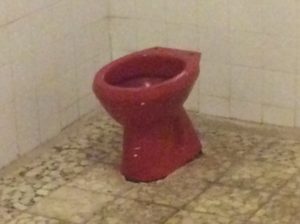
Hoxha’s bright red commode was intended to get him through years of post-nuclear attack. Photo by Robert Waite
It is a monument to the kind of folly that is possible when an authoritarian figure is given free rein.
Today, it doubles as an art installation venue and a tourist attraction. It’s difficult to describe the scale of the place or the technology employed to filter air, access safe water, store food – all the things a dictator might need for a two- or three-year stay while the dust settled. You get to see the great leader’s office; his bedroom; and, yes, his bright red commode.
There is much else to see in Tirana and the surrounding countryside. The city has thrown off its drab communist veil and pulsates with life – or at least it did, pre-COVID-19.
The upcoming November edition of Film Festival is still scheduled to go ahead. But even if it doesn’t, it seems sure that like the city and country itself, it will be resurrected. My dream of visiting Albania was delayed four decades – but it was worth the wait.
If You Go
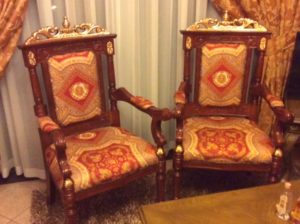
The furniture in the hotel was a bit garish.
We stayed at the Dinasty Hotel in Tirana, which bills itself as “Tirana’s Luxury City Hotel.”It’s a bit funky – the room furniture was fit for a Caliph – but we would recommend it, if only for the quality of its kitchen. The Sheraton is a good alternative.
In terms of getting there, we would not recommend driving to Albania – at least not with your own car. There are ferries to the Albanian coast from Italy and Greece. Flights to Tirana from multiple European cities are available on Austrian Airlines, British Air, Lufthansa, Pegasus Airlines and Turkish Airlines, among others.
The currency is the leke, but Euros are widely accepted.
If you read part I of this series, you might be wondering how we got the Mercedes around Bosnia and back into the E.U. Turns out we discovered that there is a ferry that does an end-run. It is purported to be filled with pirates, smugglers and other unsavory characters.
We felt right at home.
Author Bio: Robert Waite has written on travel for almost 50 years. A former Pacific News Service correspondent in Eastern Europe, he is a professor at Seneca College in Toronto and Managing Partner at Waite + Co., a communications consulting firm with offices in Boston, Ottawa and Toronto.
You might also like these other posts by Robert Waite:












One Response to Albanian Travel Dreams Fulfilled